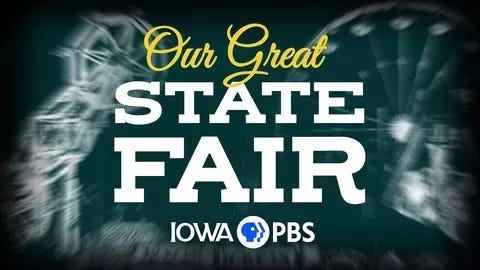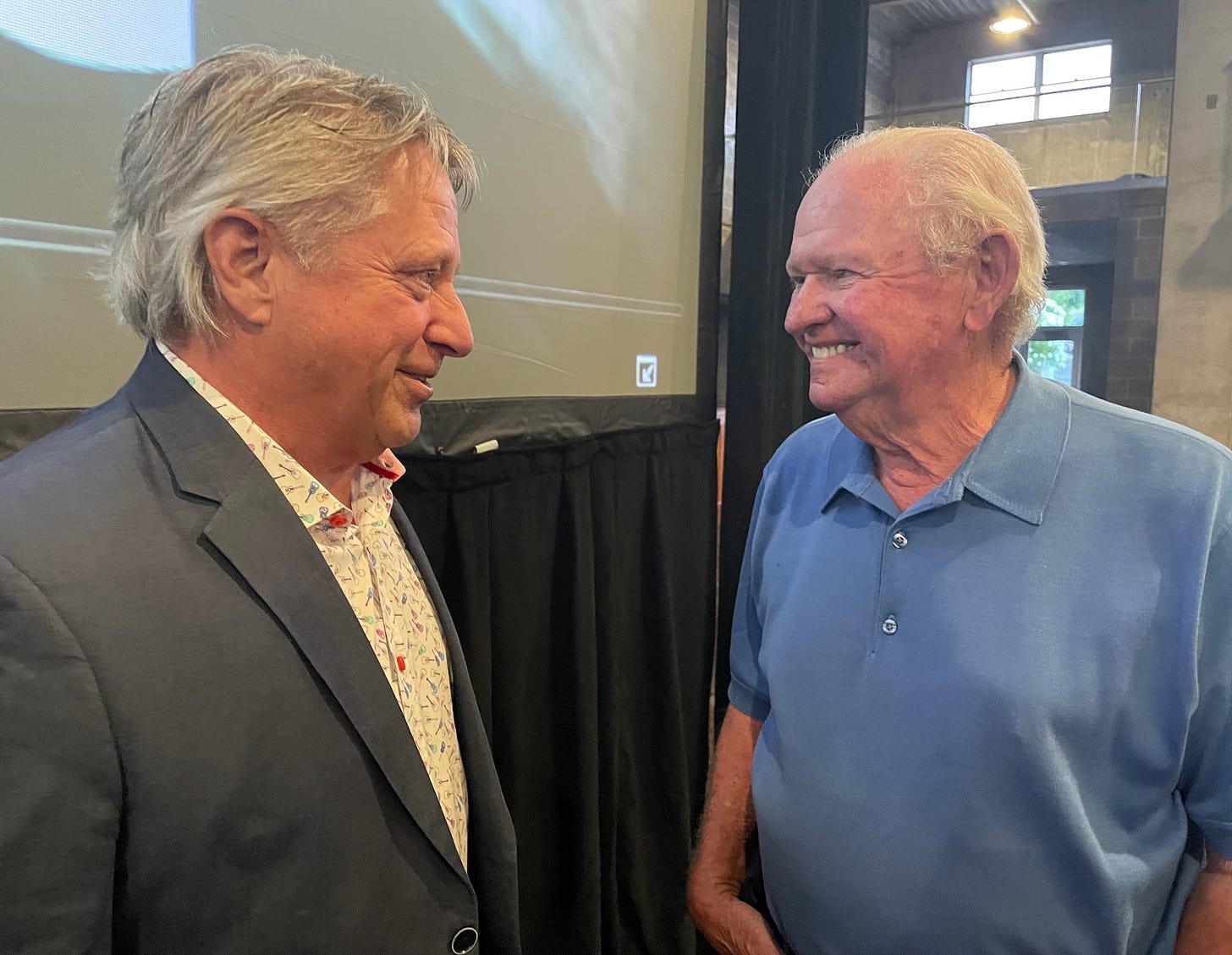Must-see TV: "Our Great State Fair"
Tonight, Aug. 1, and Wednesday, Aug. 2, Iowa PBS presents its new documentary, covering 170 years of state fair history. You'll learn a lot, laugh, cry & feel new pride in our state.
DES MOINES, Iowa — When Theresa Knight, a producer & director at Iowa PBS television, called me last fall and said she wanted to interview me for a new documentary on the Iowa State Fair, I asked her, “What part of it? What’s going to be your focus?”
Her answer: “All of it.”
I don’t think I said it, but my thought: “That’s a whole lot of history, sister! And I’m glad it’s you doing it, not me.”
She and her colleagues did it, all right. Their story “Our Great State Fair,” covering 170 years of history in two hours, is as impressive and comprehensive a reporting job as I’ve seen on local television.
We can all see their work tonight and Wednesday night, Aug. 1 and 2. The two-hour production is being broken into hour-long episodes for TV, and those will air at 7 p.m. both evenings. You can stream them online, too, by going to www.iowapbs.org.
The Iowa PBS logo for the new documentary.
It’ll be a perfect primer for this year’s state fair, which runs Aug. 10-20.
County fairs had already started in early Iowa when in late 1853, leaders in the southeast Iowa community of Fairfield decided it was time to try a state fair, the documentary tells us. They formed the Iowa State Agricultural Society and, on Aug. 25, 1854, opened a 3-day state fair. The Fairfield Ledger estimated 7,000 to 8,000 attended.
The second state fair was held the following year in Fairfield, and admission tickets were 25 cents apiece. In 1857, the state fair moved to Muscatine, and then began 25 years of moving around among 10 different cities in eastern Iowa. By 1879, it moved permanently to Des Moines.
In the documentary, the story is told through the writing of Knight, narration by Cedar Rapids native Jennifer Clark and dozens of interviews with people who’ve been deeply involved in operating the fair, covering it or simply attending it.
How much time did Knight put into the report?
“Well, 365 days, eight hours a day,” said one of her colleagues Cameron McCoy, a senior producer at Iowa PBS. “We’ve got to get her a vacation now.”
Theresa Knight of Iowa PBS.
That was two weeks ago, after she and her Iowa PBS colleagues had screened it for 200 of us who’d gathered in the auditorium of the Oman Family Youth Inn on the fairgrounds. We gave the crew a standing ovation after we’d seen it.
Things the documentary includes and you don’t want to miss:
—The state fair’s evolution from being a learning lab for Iowa farmers, which it still is, to including entertainment. Lots and lots of entertainment. Like the strippers who were the rage in the 1920s and ’30s. A Des Moines Register & Tribune reporter dutifully covered one of the first shows and told his readers that the star, Rhodora, “removed all her clothes.” Probably packed the place the next day.
—The great 1896 staged collision of two steam-powered locomotives in front of the grandstand, resulting in a huge explosion, fire and total damage to the engines. That was the first of a couple such collisions at our fair. The best-known promoter of them was a Joe Connolly, who earned the nickname “Head-On Joe.”
—You’ll see the early races between race cars and airplanes (flying low), starring the uber-famous Eddie Rickenbacker, a World War I flying ace and race car driver.
—The building of the classic brick buildings of today, most of the early ones in the grand “exposition” architecture style developed for world’s fairs.
—The “Healthy Baby Contests” in the 1930s and ’40s, starring the cutest Iowa kids ever.
—The debut of TV at the state fair in 1946, signaling the start of the iconic career of “Mr. State Fair” Bill Riley, best known for his development and hosting of the “Bill Riley State Fair Talent Contest,” which continues today. You’ll see Bill Riley Jr. take over, too, and he’s still much involved in state fairs today.
Two of the Iowa State Fair MVPs are Bill Riley Jr. and John Putney, shown here after the documentary screening.
—The importance of fair secretary and general manager Kenneth Fulk, who was in charge for 14 years before 1976. In Fulk’s tenure, he boldly started contracting national stars of entertainment — Johnny Cash, Dolly Parton, Bob Hope, Lawrence Welk. And of course, that continues today, with the fair always featuring the stars of not only today and yesterday, but also of tomorrow. Which reminds me: One of Fulk’s successors as fair general manager, Marion Lucas, told me, “The first time Garth Brooks played the Iowa State Fair, he drove his own bus on to the fairgrounds. Now he flies in on his own jet.”
—The documentary does Butter Cows, hog calling, husband calling, fiddling and men being shot from cannons. You’ll see an airplane fly right into a house in a daredevil act in front of the grandstand. You’ll feel the drama and nerve-wringing of the animal judging. Ditto during judging of all kinds of homemade foods.
—It explains how presidential politicians long ago discovered the Iowa State Fair and continue visiting today to campaign. “The Iowa State Fair, every four years when we’re electing a president, is the center of the universe,” National Public Radio reporter Don Gonyea, tells Knight. “It just is.”
—It explains how farmer John Putney, of Gladbrook, who’d been a volunteer in the cattle shows, read a scolding column by Des Moines Register editorial writer Rox Laird in the late 1980s, saying “the state fairgrounds are a disgrace.” Said Putney: “I knew Rox was right. I went to the fair board and said it’s time to fix this.” He helped organize and was the first director of the Blue Ribbon Foundation, which as of now has raised more than $200 million that has transformed the place.
It truly is, as God intended, “Our Great State Fair.” (And, yes, you can sing along on the second line, “The best state fair in the state!”)
—
You can comment on this column below or write the columnist directly by email at chuck@offenburger.com.
—







way to go Chuck! Nice piece.
Hope you didn't get soaked or blown away on the RAGBRAI leg from Tama to Coralville. Some nasty stuff went through. Despite a whole evening of meteorological weather gadgetry most of the local boots-on-the-ground TV coverage was fillmed during the day when the weather was nice and organizers were waiting for folks to arrive. We heard on social medial some folks were still straggling in after the grueling Des Moines-to-Tama leg the day before.
I did hear one local anchor drag out the tried and true "rain didn't dampen the spirits" line. geez.
Chuck,
Nice piece.
I now live in South Arkansas. You brought back memories. I remember going to the state fair a few times as a kid. Most of my fair experiences came through PBS at 9:00pm and Morgan Halgren (sp). They did a recap of day’s highlights and some canned features.
I happened to see the Bay City Rollers. ( who?) and Pat Benatar on different years. Benatar was during a heavy thunderstorm.I’m not sure that concert would be allied now days. At 63 , the fair is all about memories. I’ll be watching tonight via steaming. Thanks for the heads up!
Lon Tegels
Monticello AR